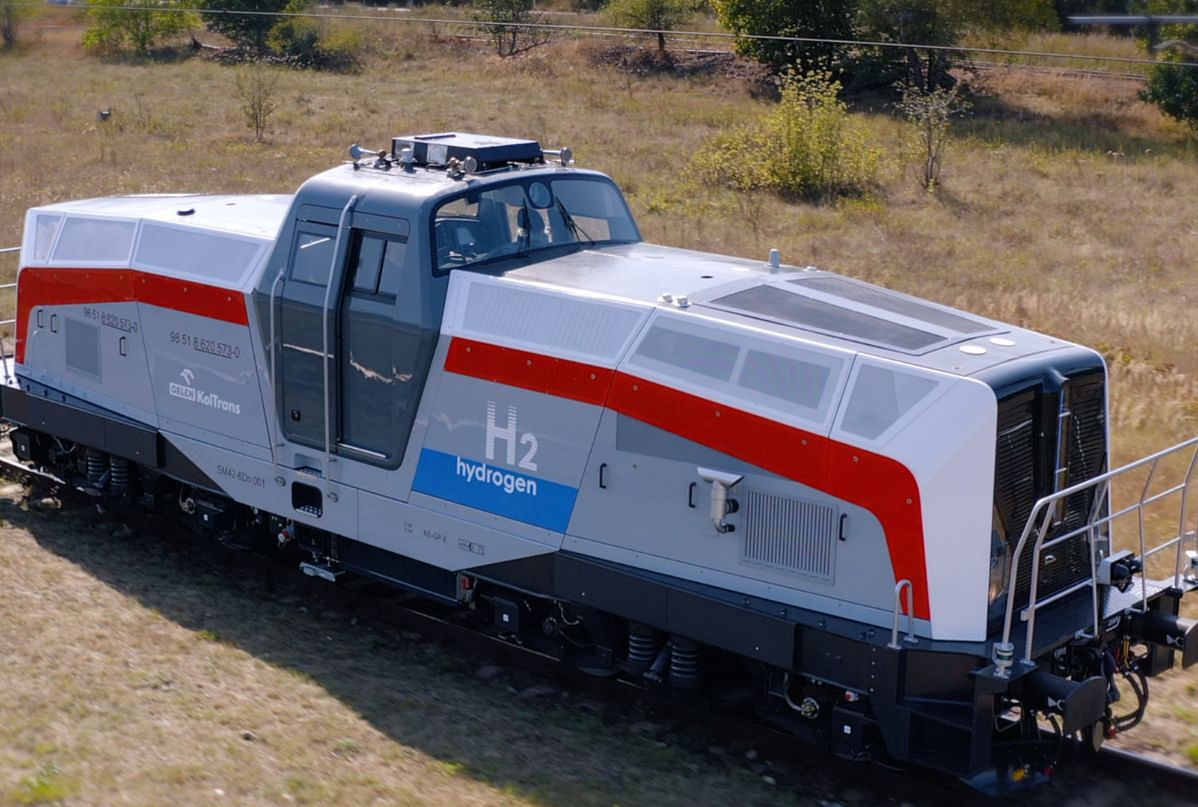First hydrogen locomotive started working in Poland.
Imagine if we somehow could run trains on electricity, that would be even better
They already do, they just have a diesel generator to make the electricity
Guessing that replacing that with a large battery that charges at night is unreasonable due to the torque needed? You’d probably need a battery larger than a train engine to be able to even do a few stops and starts. Which is why electric trains are wired all the time.
If someone knows for sure I’m super curious!
This is exactly what I was looking for, thank you!
Is this whole thread a joke or have you people not heard of electrified rail
I mentioned it in my comment that you’re replying to. “wired” could easily refer to above or below, just continuous current is what matters for this discussion. Why do ask?
Edit: Wait did you think we can electricity all rails? Outside of major cities it’s a maintenance and safety nightmare, and a LOT of our freight moves via rail.
Trains are already pulling what 100 cars. It’s easy enough to have a car that’s a battery. But I think overhead lines are the way to go on the vast majority of lines.
The problem with battery trains is that locomotives hardly sit around long enough to charge unless it’s some sort of switcher or in for maintenance. Really the only use case for battery locomotives outside of switchers is passenger service where it’s fairly common for a train to sit for eight plus hours. Amtrak and Siemens are actually doing this with 15 of the new airo trainsets which will run on the empire line. The trainsets will specifically run on battery while within the new York city tunnels where diesel locomotives are only allowed to operate under emergency.
There is probably a use for train with battery on partially electrified lines.
The train charge on the electrified part and use batteries on the rest.
For transport of people, it seems germany has some train with battery. They replace their hydrogen trains.
Supercapacitors.
If I ran the local power grid I’m not sure I’d want cargo trains using line power for traction, unless there was some mandated weight or length limit 🤔
Without some cargo limit I think sections of the line’s voltage will just collapse under the current being drawn, whenever the cargo train moves off from a complete stop - especially if it’s a multi mile long cargo train that seems common in the US
The Kiruna - Narvik electrified line is operating just fine with LKAB running the heaviest trains in Europe with a mass of 8600 tonnes.
There’s little chance of that happening, but even if there was, they’d just use batteries for the acceleration phase. That’s what hydrogen fuel cell trains do anyway, because the fuel cell can’t produce enough power on it’s own to accelerate the train from a stop, so they’re used to charge batteries that allow it to do so.
The reason why there’s little chance of that happening is there are already very many cargo trains powered by overhead lines. We’ve been doing it for 150 years and in continental Europe there are many sections of track that are entirely electrified because it made more economic sense than running a wasteful (compared to a steam power plant) diesel generator to power the already electric engines of the trains.
I really can’t see a train pulling so much that it crashes the entire system. *When you think about it it’s one (moderate size) generators worth.
90% off the cargo trains are powered with electricity in France and can reach up to 750m.
I agree It’s not multi mile long but it’s totally possible to have electric cargo trains.
I don’t know about Poland but I know about France (I would guess we’re not so far appart on this point).
While 95% of railways are electrified, those last 5% are not very worth it to invest in, because really low traffic and hard to operate (eg. in mountains). I’ve already heard of compromises, like hybrid locomotives that can run on battery for more than half the line and rely on diesel for the remaining.
all trains, even the speed trains, in france run on electricity for who knows how many decades.
same trains go to great Britain, Belgium, Netherlands, Germany and maybe some other countries too.
source of the electricity is debatable though. France produces a great majority of its electricity from nuclear since the ww2 trauma.
Not trying to start a fight or anything, but don’t we still ‘need’ to burn a lot of coal to fuel electricity? Renewables haven’t gotten close to pushing the necessity of coal away yet, no? Why not alternatives like this in some places to offset the need for electricity?
Hydrogen doesn’t exist randomly in a well or something it has to be created by using electricity - and that transformation is very inefficient if you then use the hydrogen in an inefficient way to power an engine instead of just using the electricity directly
That argument that energy is coal-heavy actually counts against hydrogen…
Hydrogen powered stuff only makes sense when electric isn’t an option like for planes that just can’t carry heavy batteries
Apparently, some hydrogen does come out of the ground like methane: https://www.weforum.org/agenda/2023/09/white-hydrogen-deposit-france/ but I assume it’s not abundant enough to make a difference
You don’t have to use electricity to make hydrogen! You can make it from methane! But yeah, it’s probably even worse than a diesel engine when it comes to CO2 emissions…
While it technically doesn’t you “need” electricity, Methane Pyrolysis requires energy of some sort.
The issue to me in term of effeciency is that the production of hydrogen needs electricity, the movement of it needs electricity, the storage and pumping of it needs electricity, and so on. I’d rather see all that electricity in the process simply be moving the vehicle. Though lugging batteries along is an issue in it’s own.
What about wire?
Nuclear is the energy source that scares everyone but that is actually the most viable option to power the world until renewable becomes the dominant one.
Thorium has been the best solution all along but it can’t be weaponized so countries have been ignoring it for decades until recently
While it may not be the best option, is it not good that somewhere is at least trying it?
As long as it’s not widespread adoption, it seems like a good idea to at least trial these sort of things on a small scale to properly determine the real world application, even if the conclusion is just “yeah, it shit”.
No! If it doesn’t immediately solve the issue completely without any drawbacks it must be scrapped and no one should work to improve it!
Best regards,
Every conservative party (and their corporate sponsors).
Most of the supporters of hydrogen trains are the Oil & Gas lobby, a traditionally conservative group. It’s another, “Technology will save us from climate change!” scheme, which will allow unabated oil extraction to continue so we can make hydrogen fuel.
If I may?
Hydrogen, green hydrogen, can be produced from water, using electricity produced from renewables, like solar amd wind.
My own country is in the process of converting a decomissioned refinery into a hydrogen plant.
It may not solve much in the short term but as an energy reserve, hydrogen can find use directly as a fuel or for running gas turbines to produce electricity in replacement of conventional gas.
Green Hydrogen from Electrolysis is extremely inefficient (<30%). Renewable energy isn’t without cost or environmental impact, so we need to responsible with how we use it. Unless the grid you’re pulling from is 100% renewable and has excess power that is just being wasted, that renewable energy could be used elsewhere in a more efficient manner.
Why the fuck?
Trains don’t run on diesel directly. They use diesel generators to drive electric motors that actually move the train. How those motors are powered is relatively irrelevant. This just replaces the diesel generators with hydrogen fuel cells…I think. I don’t read Polish well. Or at all.
But how about replacing the diesel with fucking electrified rail network?
Because now you have to build an electrified track infrastructure in instead of using an already built railway track.
cough overhead lines cough
Jeez if only smart people thought of that.
Real answer: it’s actually a lot of logistics and technical challenge to bring overhead lines to the whole of eve a small country like England. A lot of these tracks are in regions where there’s no power lines nearby. You still want the trains to go to and through these places.
That’s logic comparing the economic costs of diesel to electric. If you compare the economics with hydrogen, it makes much more sense to run the wire with the track, independent of the availability of electricity.
Hydrogen could be used as a bridge gap measure. It’s relatively easy to move diesel engines to hydrogen. And hydrogen production, even when using gas, is still better than diesel engines.
Just put lines above the track…
Sometimes building infrastructure is more expensive than a hydrogen-powered train. I guess.
Maybe at the train track end. But creating the hydrogen and the needed infrastructure for both the creation and distribution, plus the enormous amounts of energy wasted in the production, is unlikely to be more cost effective than the investment in electrifying existing railroads.
No especially not in the long run and especially especially not regarding efficiency
It never is, and won’t be until we essentially have free energy. Any serious economic study has concluded as much.
A lot of them do, but there are also ones with mechanical or hydraulic transmission.
European politicians like hydrogen for some reason. Inefficiencies don’t matter, they are used to those.
Would this be a viable option for cruise or cargo ships as well?
The only real green option for oceangoing cargo ships at our current technology would be nuclear plants. Since small nuclear plants generally require highly enriched uranium suitable to making bombs, I don’t foresee it being an option, however.
Nuclear cargos exist. Or at least existed. URSS then Russia had one for reach a port in the north. It was an ice-breaker.
Or back to wind.
Idk how expensive these reactors are tho. The US Navy operates dozens in their fleet between CVNs and SSBNs, but that dwarfs the rest of the world.
Thorium Molten Salt reactor can’t be used for weapons because it’s no fissable so it can’t have a chain reaction that creates explosions
Yeah, I wouldn’t consider the thorium fuel cycle as part of our current tech. India’s going to be the first to start thorium breeding at scale which they haven’t gotten close to doing to date. That said, Thorium fuel absolutely can produce nuclear weapons in a breeder reactor design, it’s just more difficult because you have to reprocess the fuel for U233 which is what Thorium is bred into.
There are lower enrichment targets you could theoretically use for a small uranium reactor depending on your moderator. It’s just easier to use highly enriched uranium, or maybe some sort of MOX fuel.
Not a very good one.
Hydrogen density is too low, there is more hydrogen in things like ammonia or methanol. All of these are potential solutions to fossil bunk fuel or LNG, but all have issues and there is no clear winner yet.
I cannot understand the future use case of hydrogen locomotives. Who even funded this thing.
Big oil and gas fund it. Main source of hydrogen right now is from oil drilling.
Why not?
Batteries can’t keep nearly as much power in a space as burnable fuel can, it’s just physically impossible because the oxygen you add to fuel gives it a far higher energy density where batteries need the oxygen built in.
Something like a locomotive also needs an absolute shit ton of power to pull the trains they pull, so you’re going to have a lot of difficulty and it’s going to be pretty expensive running high voltage lines across these railroads.
Hydrogen, because of railroad can easily control the infrastructure and fill up a train, run it right away, and refill it at its destination, could actually be a pretty viable option
There are zero sources of green hydrogen in the foreseeable future and railways can be electrified. Small runs that aren’t electrified can use batteries. There is a zero use case for a leaky fuel that we source from creating CO2 like hydrogen. The idea of using wastefully using electrolysis to something we can deliver power directly to is ludicrous.
Edit: I can think of ONE use case, and that’s maybe logging locomotives that will never be electrified.
As we move into green energy we’re going to have an excess of power at times that we don’t need it, and there’s going to be many use cases where stuff like electrolysis, even though it’s wasteful, is ultimately well worth it because power will be cheap to free during those times of day.
Not in my lifetime, that’s for sure. We currently supply nearly all agricultural hydrogen from oil cracking, for example. There may be a future where wastefully using hydrogen makes sense, but it’s not anytime soon. An actual solution is electrifying the train lines.
California literally already has the problem of excess energy on occasion, and it’s only going to get worse and worse as time passes until we create some sort of magical low cost energy storage solution.
Hydrogen is created from fracking now because we live in a fossil fuel world right now, but eventually as we’re forced to move away from it you’re going to have to have high energy density systems, and hydrogen is one of the few fairly reliable ways to do that.
Electrolysis is wasteful, but so are internal combustion engines.
That’s not what folks should seriously be comparing this to. You can run electric wires directly over the damn rail and feed a train off the grid. That’s where money should’ve be going everywhere 20 years ago. Running a train off of a diesel electric generator is dumb too frankly.
If hydrogen ever becomes a real thing, maybe for using green energy in remote areas where electric isn’t feasible or economical, maybe the cost to waste some peak solar/wind to generate hydrogen via electrolysis will somehow make sense cost-wise.
You got any idea of the energy density of Hydrogen? On a per m3 basis, batteries hold a lot more energy.
BTW, hydrogen doesn’t get burned.
you’re going to have a lot of difficulty and it’s going to be pretty expensive running high voltage lines across these railroads.
It’s worked just fine for the past century
For what? Trolleys?
Go look at the weight of an average coal train and remember that most of these railways go through some of the most criminal regions of the country with lots of burnable forest land running around the tracks
For what? Trolleys?
For most trains in Europe. For example I can mention the Iron Ore Line in north Sweden which has 8600 trains. Which isn’t as heavy as some of the coal or ore trains around the world, but it’s at up to a 1% incline.
Just because the US never electrified it’s train infrastructure after the obsoletion of the steam engine doesn’t mean other folks didn’t. Many trains straight up use their diesel engines as electric generators for electric motors. Electric cargo trains are cheaper to run than diesel, but the upfront cost is more expensive. Guess which option the non-state run train infrastructure of the United States chose. We’re still seeing massive resistance from the train companies for doing it because they don’t want to pay the cost.
Fills up in a comparable time span as diesel locos, and the hydrogen storage would be much lighter compared to equivalent battery storage. No need for an onboard AC/DC generator for the traction motors too, as would be the case if it was diesel powered.
To me it seems like an ideal diesel loco replacement
I assume it will be hauling cargo, not passengers…
It’s a very dumb solution to things that run on tracks and can be directly electrified. It’s mindbogglingly silly.
We need more of those and everywhere
No we need electrification of the fucking train tracks, the efficiency of hydrogen is absolutely unreasonable, especially for trains.
A part of the network is difficult to electrify and it cost a lot. So H2 still a good alternative.exoerinentation since 2016 show that it is successful. In France there is 1415 km electrified, the small network is representing 15 000 km. You ser the point ?
I see your point but the proportions are wrong. Wiki says that ~15,000 km are electrified out of 29,900 km
Its a hell of a lot cheaper in the long run.
H2 yes probably
No just electrifying the tracks. Its cheaper in all regards, its a one time investment.
Then you’ll have to create a hydrogen distribution network. Please remember as you’re doing that -The main danger with hydrogen is what is known as BLEVE (boiling liquid expanding vapor explosion). Because hydrogen is gaseous in atmosphere
Storage and transport of H2 is a big deal because of the unique properties (very low transition temp/very high pressure for liquid). That generally means for a non-pressurized, non-cryogenic storage it has to be combined into another molecule and then catalyzed back out, real time, for use. And, of course, the ignition ratio range (4%-75% in air) means that it’s very easy to accidentally ignite a H2 leak; substantially easier than most other fuels, though this is mitigated by it’s density and ability to disperse in an unenclosed area.
Production is theoretically energy efficient as you can create it with hydrolysis, but the cheapest way of producing it, by far, is cracking of methane, which requires a high temperature process to create. It may not produce a high volume of CO2, but it perpetuates the cycle of exploration and extraction of gaseous hydrocarbons and the related environmental dangers and downsides.
No it’s not stored as liquid BLEVE is not a concern here, but there is plenty of issues with explosivity and very high preasures which can be 300-500 bar (~atm) depending on the application.
Oh, the humanity.











